Artificial Intelligence (AI) has rapidly evolved over the past few years, and one of the most significant advancements in the field is OpenAI’s ChatGPT. This conversational AI model has revolutionized the way humans interact with machines, bridging the gap between complex computational technology and user-friendly interfaces. But what exactly is ChatGPT, and why has it become such a prominent topic in discussions about AI? This article delves into the mechanics, applications, and potential of ChatGPT.
What is ChatGPT?
ChatGPT is a language model developed by OpenAI, part of the GPT (Generative Pre-trained Transformer) series. It leverages deep learning techniques, particularly transformers, to process and generate human-like text. Trained on vast datasets containing diverse information, ChatGPT can understand context, maintain coherent conversations, and provide detailed, relevant responses.
Key Features of ChatGPT include:
- Natural Language Understanding (NLU): ChatGPT comprehends user queries with remarkable accuracy.
- Context Awareness: It retains the context of a conversation, enabling multi-turn interactions.
- Adaptability: It can generate responses in various styles, tones, and languages.
- Versatility: It is capable of answering questions, drafting emails, writing articles, and more.
The Evolution of ChatGPT
OpenAI’s journey with GPT models began with GPT-1, which introduced the transformer architecture. Subsequent iterations, GPT-2 and GPT-3, brought significant improvements in terms of scale and capability. ChatGPT represents a fine-tuned version of these models, optimized for conversational tasks.
One of the critical aspects of ChatGPT’s training is reinforcement learning with human feedback (RLHF). This technique involves human reviewers rating the AI’s responses, which guides the model to generate more accurate and human-like outputs over time.
How Does ChatGPT Work?
ChatGPT is powered by a neural network architecture called the transformer, which uses mechanisms like self-attention and positional encoding. Here’s a simplified breakdown of its functioning:
- Pre-training: The model is trained on vast amounts of text data, learning grammar, facts, and even nuances of language.
- Fine-tuning: It undergoes further training with specific datasets to refine its conversational abilities.
- Inference: When a user inputs a query, the model processes it, predicts the most likely next words, and generates a coherent response.
Applications of ChatGPT
ChatGPT’s adaptability has led to its integration across various industries and use cases:
- Customer Support: Businesses use ChatGPT to provide 24/7 automated support, resolving queries quickly and efficiently.
- Content Creation: Writers leverage ChatGPT for brainstorming ideas, drafting articles, or refining text.
- Education: Students and teachers use it as a tool for learning, answering questions, and explaining complex concepts.
- Healthcare: ChatGPT assists in preliminary diagnostics and providing general health advice.
- Programming: Developers use it to debug code, generate snippets, and learn new programming concepts.
Advantages of ChatGPT
The rise of ChatGPT has brought several benefits:
- Efficiency: It automates repetitive tasks, saving time and resources.
- Scalability: It can handle large volumes of interactions simultaneously.
- Personalization: ChatGPT adapts its responses based on user preferences and context.
- Cost-Effective: Businesses can reduce operational costs by integrating ChatGPT into their workflows.
Challenges and Limitations
Despite its numerous benefits, ChatGPT is not without challenges:
- Accuracy: While it’s highly advanced, ChatGPT can occasionally provide incorrect or outdated information.
- Bias: The model can inherit biases from its training data, leading to unintended outputs.
- Over-Reliance: Users might rely too heavily on ChatGPT for tasks requiring critical thinking or human judgment.
- Ethical Concerns: Misuse of the technology for misinformation or harmful purposes is a growing concern.
The Future of ChatGPT
As AI continues to evolve, ChatGPT is poised to become even more sophisticated. Future advancements may focus on:
- Improved Contextual Understanding: Enhancing its ability to grasp nuanced and complex queries.
- Ethical Safeguards: Implementing stricter guidelines to prevent misuse and reduce biases.
- Domain-Specific Expertise: Fine-tuning ChatGPT for specialized industries like medicine, law, or finance.
- Multimodal Capabilities: Integrating text, images, and other data forms for more comprehensive interactions.
Comparison Table: Key Features of ChatGPT Versions
| Feature | GPT-1 | GPT-2 | GPT-3 | ChatGPT |
|---|---|---|---|---|
| Model Size | Small | Medium | Large | Large |
| Conversational Ability | Basic | Improved | Advanced | Optimized |
| Context Retention | Limited | Moderate | High | Very High |
| Training Data Volume | Limited | Expanded | Extensive | Extensive |
| Use Cases | General NLP | Advanced NLP | Diverse NLP | Conversational |
Conclusion
ChatGPT has undeniably transformed the landscape of AI-driven communication. Its ability to generate coherent, contextually relevant, and human-like responses makes it an invaluable tool across various domains. However, with great power comes great responsibility. As we continue to harness the potential of ChatGPT, it’s crucial to address its limitations and ensure ethical usage. With ongoing advancements, ChatGPT promises to be a cornerstone of human-AI collaboration in the years to come.

